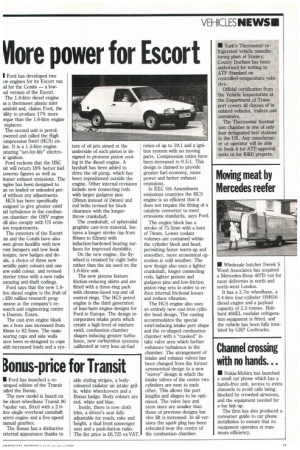wore power for Escort
Page 11

If you've noticed an error in this article please click here to report it so we can fix it.
I Ford has developed two ?.w engines for its Escort van id for the Combi — a low)of version of the Escort. The 1.8-litre diesel engine Is a thermoset plastic inlet Lanifold and, claims Ford, the ility to produce 17% more )rque than the 1.6-litre engine replaces.
The second unit is petrolowered and called the High .ornpression Swirl (HCS) enme. It is a 1.3-litre engine .taturing "set-for-life" electroic Ford reckons that the HSC nit will return 18% better fuel conomy figures as well as leaner exhaust emissions. The ngine has been designed to Lin on leaded or unleaded petol without any adjustments. HCS has been specifically esigned to give greater swirl nd turbulence in the combusion chamber: the OHV engine rill also comply with US emision requirements.
The exteriors of the Escort an and the Combi have also een given facelifts with new rant bumpers and tow hook lesigns, new badges and deals, a choice of three new netallic paint colours and one Lew solid colour, and revised aterior trims with a new radio eaturing anti-theft codings. Ford says that the new 1.8itre diesel engine is the fruit of L 250 million research progmrne at the company's rewarch and engineering centre n Dunton, Essex.
The cast-iron engine block as a bore size increased from 30mm to 82.5nun. The main)earing caps and side walls lave been re-designed to cope with increased loads and a sys tern of oil jets aimed at the underside of each piston is designed to promote piston cooling in the diesel engine_ A layshaft has been added to drive the oil pump, which has been repositioned outside the engine. Other internal revisions include new connecting rods with larger gudgeon pins (26mm instead of 24mrn) and rod bolts revised for block clearance with the longerthrow crankshaft.
The crankshaft, of spheroidal graphite cast-iron material, features a longer stroke (up from 80rrun to 82mm) with induction-hardened bearing surfaces for improved durability.
On the new engine, the flywheel is retained by eight bolts rather than the six used on the 1.6-litre unit.
The new pistons feature friction-reducing skirts and are fitted with a three-ring pack with chrome-faced top and oil control rings. The HCS petrol engine is the third generation of lean-burn engine designs for Ford in Europe. The design incorporates intake ports which create a high level of mixture swirl, combustion chamber shapes inducing greater turbulence, new carburation systems calibrated at very lean air/fuel ratios of up to 19:1 and a ignition system with no moving parts. Compression ratios have been increased to 9.5:1. This design is claimed to provide greater fuel economy, more power and better exhaust emissions.
In EEC 5th Amendment emissions countries the HCS engine is so efficient that it does not require the fitting of a catalytic converter to meet emissions standards, says Ford.
The engine block has a stroke of 75.5mm with a bore of 74mm. Lower coolant volumes are contained within the cylinder block and head, permitting faster warm-up and smoother, more economical operation in cold weather. The new design also uses a lighter crankshaft, longer connecting rods, lighter pistons and gudgeon pins and low-friction piston ring sets in order to reduce internal frictional losses and reduce vibration.
The HCS engine also uses an entirely new cast-iron cylinder head design. The casting accommodates the special swirl-inducing intake port shape and the re-shaped combustion chamber with a "masked" intake valve area which further enhances turbulence in the chamber. The arrangement of intake and exhaust valves has been changed from the former symmetrical design to a new "mirror" design in which the intake valves of the centre two cylinders are next to each other. This allows the port lengths and shapes to be optimised. The valve face and stem sizes are smaller than those of previous designs but Ave lift is increased. In all versions the spark plug has been relocated near the centre of the combustion chamber.














































